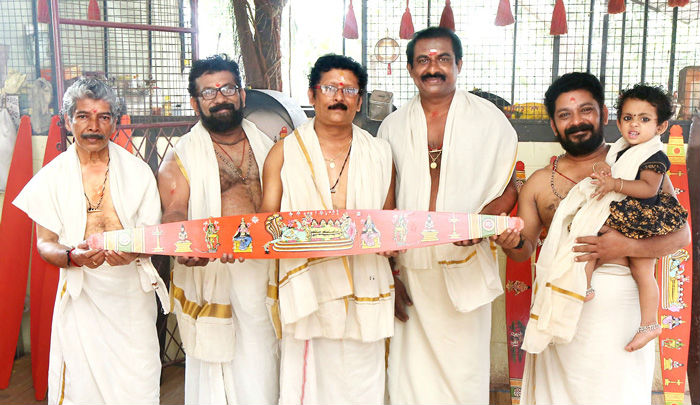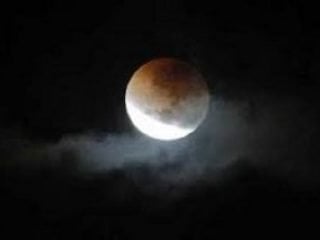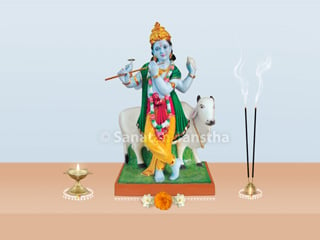

1. What is an Onavillu ?
In Malayalam the word Onavillu is created from two words Onam and Villa. Vaman Jayanti is celebrated on the twelfth day in the bright fortnight of Bhadrapad, that is Vaman Dwadashi. In Kerala Onam is celebrated on that day. Villa in Malyalam means bow. Villas are offered at the famous Shri Padmanabhswami temple in Thiruvantapuram in Kerala on the day of Onam. This bow is called an Onavillu.
2. History of the Onavillu
(a flat, broad, elongated wooden craft portraying miniature paintings of Shrivishnu in various forms, from the spiritual perspective)
The tradition of creating Onavillus is more than thousand years old. According to a legend Bhagwan Shrivishnu sent King Bali to hell (patal) assuming the incarnation of Vaman (the dwarf). King Bali prayed to Shrivishnu ‘May I be able to get a vision of You on the earth every year.’ Shrivishnu blessed thus ‘Every year on the earth you will see my incarnations on the earth, in the form of drawings.’ To enable King Bali to get this vision Shri Vishwakarma sketched drawings of incarnations of Shrivishnu on the wood of the kadamba (burflower) tree. This is the Onavillu. Thereafter the practice of offering onavillus at the Shri Padmanabhswami temple every year on the day of Onam started.
(Note) Descendants of Vishwakarma, the wood artisan of the Deites from Thiruvanantapuram, Kerala Mr. R. Binkumar and his family members are continuing this ancient tradition.
Note – (Reference : Information brochure on the Onavillu)
3. ‘Information on Mr. R. Binkumar and
his family, the artisans creating the Onavillus
In 1729 after Martand Varma became the king of Travancore he renovated the Shri Padmanabhswami temple (Note). Ancestors of Mr. R. Binkumar came from Thiruvattar Tamilnadu to Travancore to do the wood carving work of this temple. Ever since the seva of making onavillus to offer to the Shri Padmanabhswami temple lies with the family of Mr. R. Binkumar.
Note – (Reference : http://spst.in/temple-history/ )
4. Process of making onavillus
Making onavillus is a traditional art which includes cutting wood, painting it, drawing pictures on it etc. in stages. The process is being followed meticulously as per tradition. The stages of making onavillus are as follows.
4 A. Cutting wood in the shape of a bow and painting it red
Dry wood from the kadamba tree is cut in the shape of a bow. The size varies from 1 to 26 meters length, and 10 to 15 cms breadth. This wood cut in the shape of a bow is painted red.
4 B. Stenciling the drawings of Deities on to the wood and painting them
With a pen pictures of Deities are stenciled onto the wood. Then those drawings are painted.
4 C. Depicting spiritual emotion on the faces of Deities
The drawings of Deities, their vehicles etc are drawn in black colour. Finally spiritual emotion through eyes, face, nose etc are depicted.
4 D. Decorating with tassels
After painting is completed red thread tassels are tied at both ends of the onavillu.
5. Some features of the onavillu and the process of creating it
5 A. Use of natural dyes and specific meaning of the colour
Natural dyes are used in onavillus – mainly red, yellow, green, blue, black and white. The colours used in the drawings and spiritual emotions associated with them are given further.
| Colour | Spiritual emotion |
| 1. Red | Courage and love |
| 2. Yellow | Knowledge |
| 3. Green | Expansiveness |
| 4. Blue | Will power |
| 5. Black | Penance |
| 6. White | Purity |
5 B. Types of onavillus and fulfillment of desires of devotees
Traditionally six types of onavillus are created. On the festival of Onam the onavillus are kept in the temple of the respective Deity in the vicinity of the Shri Padmanabhswami temple. For example onavillus with Shrivishnu reclining on Sheshnag are kept in the main temple of Shri Padmanabhswami, that of the picture of Shri Vinayak in the Shri Ganesh temple etc.These onavillus are also available for sale. Generally devotees buy the onavillus required for fulfillment of their desires. Given in the table below are types of onavillus, drawings of Deities on them and desires of devotees.
| Type of onavillu | Drawing of which Deity | Desires of devotees |
| 1. Anantshayanam villu (Shrivishnu reclining on Sheshnag) | Shri Padmanabhswami | All kinds of wealth and Divine grace |
| 2. Dashavtaram villu (Depiction of ten incarnations of Shri Vishnu) | Ten incarnations of Shrivishnu | Protection from enemies |
| 3. Shrikrushna leela villu (depicting Divine play of Shrikrushna) | Various Divine plays in the life of Shrikrushna | Progeny to issue-less couples |
| 4. Shri Rampattabhishekham villu | Shrirama sitting on the throne along with Seeta | Marital happiness |
| 5. Shri Dharmashashtha villu | Shri Ayyapan | Overcoming the planetary defect of Shani |
| 6. Vinayakan villu | Shri Ganapati | Relief from all calamities |
5 C. The thread tassels tied to either end of the onavillu
are made by prisoners from jail as sevas, for atonement of sins
Prisoners who wish to render this seva as atonement have to follow certain rules meticulously and till date it is found that they do so with intense spiritual emotion.
5 D. What the spiritual emotion on the face of the Deity
in the onavillu should be is revealed to the artist in a vision in a dream
When creating an onavillu the spiritual emotion on the face of the Deity should be done last. This is done by Mr. Sudarshan, brother of Mr. R. Binkumar. As the painting is done by hand no two onavillus are exactly the same, there is at least some difference in spiritual emotion on the faces. Mr. Sudarshan is revealed which spiritual emotion should be depicted at night through a dream in the sleep. The following day he completes this.
5 E. Making onavillus is a rigorous vowed religious
observance (vrat) and God Himself gets this seva done
Mr. R. Binkumar, his brother and other family members when rendering seva of making onavillus do it as a vowed religious observance following all traditional rules. All sevas are done in the temple situated close to their residence. In fact the entire family contributes towards it. In case of any errors in making onavillus God makes them aware of them through different media. They also receive messages on what to do next. The family has received many such spiritual experiences some of which are listed further.
5 E 1. God conveys that restrictions are not being followed meticulously through the medium of a black cobra
Mr. Binkumar had just learnt the seva of making onavillus from his father. When rendering this seva at a wedding banquet he unintentionally consumed non-vegetarian food. The very next day when he was painting an onavillu, from the tiled roof a baby cobra fell on his hand. Encircling the onavillu he was holding in his hand the cobra raised its hood. It was then that it struck Mr. Binkumar that due to carelessness he had broken regulations of the observance. In his mind he asked Shri Padmanabhswami for forgiveness after which the cobra crawled down from the onavillu and departed.
5 E 2. Receiving a divine message to make small onavillus affordable to all devotees
As usual Mr. Binkumar was leaving the Shri Padmanabhswami temple after paying respects, contemplating on how to make onavillus affordable to seekers from all social strata. On the way he collided with a hermit (sadhu). He stopped and asked for forgiveness.The hermit told him ‘make an onavillu of the size of the chest’ and left. Never again did Binkumar spot that hermit there but as suggested by him started making onavillus of 30 cm length far less priced that the usual ones. This received an overwhelming response from devotees. The onavillus made formerly were 1 to 1.25 meters long and 10 to 15 cms wide and were priced at rupees 2500 or more which was not affordable to all.
5 E 3. The seva of making onavillus was given to other artists but after devotees pointed out shortcomings in these onavillus to the temple administration the seva was returned to the family of Mr. Binkumar
Due to strict religious restrictions which have to be observed when making onavillus only a limited number can be made. As the demand for onavillus is far greater than the production some members from the temple administration felt that more onavillus needed to be made. Mr. Binkumar however refused to increase the production commercially breaking traditions. Hence this seva was allotted to other commercial artists. The onavillus made by these commercial artists had several shortcomings. Devotees buying them brought these to the notice of the temple administration. After receiving several complaints the temple administration realised its mistake and returned the seva of making onavillus to the family of Mr. Binkumar. In this way God did not allow the seva to be taken away from Mr. Binkumar.

 Maghi Shri Ganesh Jayanti 2024
Maghi Shri Ganesh Jayanti 2024 Partial lunar eclipse of October 2023 – Do’s and Don’ts
Partial lunar eclipse of October 2023 – Do’s and Don’ts Main places of pilgrimage of Deity Datta
Main places of pilgrimage of Deity Datta Photographic Divine vision of some places which have experienced Shrikrishna’s blissful presence !
Photographic Divine vision of some places which have experienced Shrikrishna’s blissful presence ! Jananashanti ritual for baby born in an inauspicious period
Jananashanti ritual for baby born in an inauspicious period Mangaldosh – concept and misconceptions
Mangaldosh – concept and misconceptions